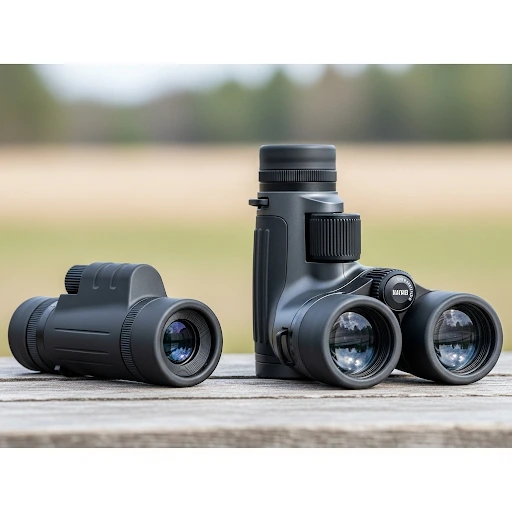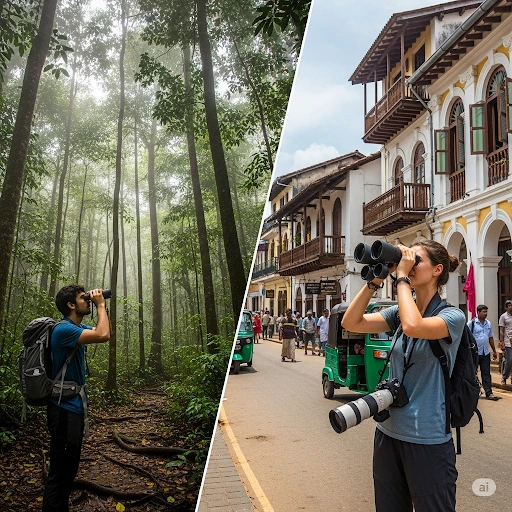No products in the cart.

Outdoor exploration, birdwatching, and travel photography often call for a closer look at the world around us. In Sri Lanka, where lush rainforests meet endless coastlines, the right viewing gear can make all the difference. At Colper.lk, we’ve seen a growing interest in compact optics that balance portability with performance. While binoculars have been a long-standing favourite, monoculars are fast becoming the go-to choice for many due to their size and ease of use. Deciding between the two requires a closer look at how they differ, what each offers, and which will serve you best in local conditions.
Understanding the Basics: How Monocular vs. Binoculars Differ

A monocular is essentially half of a binocular—one lens system instead of two. This single scope design is lightweight, easy to carry, and quick to use, making it perfect for those who prefer minimal gear. Binoculars, on the other hand, use both eyes to view, offering depth perception and a wider field of vision. The choice between a monocular vs. binoculars often comes down to portability versus immersive viewing.
For example:
- Monoculars: Compact, easy to store in a pocket, quick to focus, and ideal for short-term viewing or when mobility is a priority.
- Binoculars: Heavier, bulkier, but deliver a richer visual experience, especially for prolonged observation.
While binoculars can be more immersive, monoculars excel in convenience—particularly when hiking, travelling, or moving through crowded spaces where carrying large optics isn’t practical.
Portability and Weight: The Travel-Friendly Factor

For those trekking through Sinharaja Forest Reserve or exploring Galle Fort’s narrow streets, portability can be just as important as magnification power. Monoculars generally weigh less and occupy a fraction of the space of binoculars.9 This makes them a favourite for travellers and hikers who value speed and agility over extended stationary viewing.
Many travellers have found that choosing a lightweight, mid-range monocular allowed them to explore without the burden of extra gear, while still catching detailed glimpses of wildlife and landscapes.
Binoculars, while bulkier, may be worth the extra weight for birdwatchers or sports spectators who spend long hours observing. However, the portability of monoculars often means they’re used more spontaneously—pulled out of a pocket the moment something interesting comes into view.
Optical Performance: Clarity, Depth, and Detail
Binoculars win when it comes to depth perception because you’re using both eyes to create a 3D effect. This can be essential for activities like birdwatching where distinguishing distance and movement matters. They also tend to be more comfortable for extended use since both eyes share the workload.
Monoculars, however, can rival binoculars in clarity and magnification if you choose a quality model. High-end monoculars often feature the same optical coatings and glass used in binoculars, so image sharpness can be excellent.
Those who have explored different monocular specifications know that even budget-friendly models can surprise you with clear, bright images when chosen carefully for local conditions.
For quick spotting, navigation, or photography assistance, monoculars can be more practical because you can operate them with one hand while keeping the other free.
Best Uses in the Sri Lankan Landscape
The decision often comes down to your main purpose. To help you choose, consider this summary of monocular vs. binoculars for different activities:
- Wildlife and Birdwatching: Binoculars offer better depth and immersion, making them ideal for watching birds in Kumana National Park or observing elephants in Udawalawe.
- Travel and Urban Exploration: Monoculars shine when moving through city streets, temples, or markets where quick and discreet viewing is preferable.
- Hiking and Trekking: Monoculars are the clear winner for light packing and one-handed operation, especially on steep or rugged trails.
- Sports and Events: Binoculars can give a more engaging experience for cricket matches or cultural performances, where viewing is prolonged.
It’s worth noting that some hikers prefer carrying both—a compact monocular for quick views and a pair of binoculars kept at base camp for extended observation sessions.
Budget Considerations and Value for Money
In Sri Lanka, the cost of quality optics can vary widely depending on brand, build, and features. Monoculars tend to be more affordable than binoculars with comparable optical quality, making them an attractive entry point for beginners.
However, cost alone shouldn’t dictate your choice. Factors like waterproofing, fog resistance, lens coatings, and field of view all contribute to the overall value. For example, a slightly more expensive monocular with better lens coatings may outperform a cheaper, higher-magnification one in low light conditions.
Binoculars, while pricier, can offer better long-term investment if you’re committed to a hobby like birdwatching or astronomy. In either case, choosing reputable optics from trusted sellers ensures you get authentic products designed for local weather and lighting conditions.
Making the Choice That Works for You
When deciding between a monocular and binoculars, think about your main use case, the environments you’ll be in, and how much weight you’re willing to carry. For many in Sri Lanka, the choice is shaped by a mix of travel convenience, landscape diversity, and budget.
At Colper.lk, we understand that every outdoor experience is unique. That’s why we offer a curated range of monoculars and binoculars to match different needs—whether you want a rugged travel companion or an immersive birdwatching tool. The right scope is the one that makes you want to take it everywhere, ready to turn any moment into a closer look at the world.
